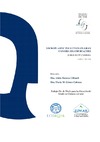Identificador persistente para citar o vincular este elemento:
https://accedacris.ulpgc.es/handle/10553/55201
| Campo DC | Valor | idioma |
|---|---|---|
| dc.contributor.advisor | Gómez Cabrera, María Milagrosa | - |
| dc.contributor.advisor | Herrera Ulibarri, Alicia | - |
| dc.contributor.author | Rapp Cabrera, Jorge | - |
| dc.date.accessioned | 2019-03-29T08:44:30Z | - |
| dc.date.available | 2019-03-29T08:44:30Z | - |
| dc.date.issued | 2018 | en_US |
| dc.identifier.uri | https://accedacris.ulpgc.es/handle/10553/55201 | - |
| dc.description.abstract | In recent decades, plastic pollution in the ocean has increased exponentially. With an estimation of more 270 thousand tons of plastics floating in the marine environment where they tend to migrate to the oceanic margins, accumulating in convective zones. The Canary Islands, located on the eastern margin of the Atlantic Ocean, are an obstacle to the Canary Current. There, it is of great interest to study the amount and type of plastic that migrates around the archipelago, as well as the proportion of plastic that washes up on the coast. This study of microplastic pollution on Canary Island beaches is a starting point for seasonal monitoring of plastic waste and future research that will aim to explain the consequences that this marine litter can have on marine ecosystems. The majority of the items observed were fragments from bigger plastic objects, more of the 50% of the items sampled. The transparent resin pellets or nurdles, semispherical items used as raw material in the productionof plastics, were found on most beachesand comprised14% of the total microplasticpollution. This was unexpected because the Canary Islands do not have a plastics industry, so this marine debris was rafted to the islands viaocean circulation. In addition, microfibers were also found, averaginga maximum concentration of 2000 items/m2. The distribution of microfiberswastotally different from that of the larger microplastics and mesoplastics, suggesting a possible endogenous origin of the contamination, probably by wastewater discharges, ravines and beach users. | en_US |
| dc.language | eng | en_US |
| dc.relation | Microtrofic | en_US |
| dc.subject | 2510 Oceanografía | en_US |
| dc.subject.other | Marine debris | en_US |
| dc.subject.other | Microfibers | en_US |
| dc.subject.other | Microplastic | en_US |
| dc.subject.other | Mesoplastics | en_US |
| dc.subject.other | Beaches | en_US |
| dc.subject.other | Canary Islands | en_US |
| dc.title | Microplastic pollution on Gran Canaria island beaches | en_US |
| dc.type | info:eu-repo/semantics/bachelorThesis | en_US |
| dc.type | BachelorThesis | en_US |
| dc.contributor.departamento | Departamento de Biología | en_US |
| dc.contributor.facultad | Facultad de Ciencias del Mar | en_US |
| dc.investigacion | Ciencias | en_US |
| dc.type2 | Trabajo final de grado | en_US |
| dc.description.notas | Departamento: Ecofisiología de Organismos Marinos (EOMAR) / Instituto Universitario ECOAQUA | en_US |
| dc.utils.revision | Sí | en_US |
| dc.identifier.matricula | TFT-46462 | es |
| dc.identifier.ulpgc | Sí | en_US |
| dc.contributor.buulpgc | BU-BAS | en_US |
| dc.contributor.titulacion | Grado en Ciencias del Mar | es |
| item.grantfulltext | open | - |
| item.fulltext | Con texto completo | - |
| crisitem.advisor.dept | GIR ECOAQUA: Ecofisiología de Organismos Marinos | - |
| crisitem.advisor.dept | IU de Investigación en Acuicultura Sostenible y Ec | - |
| crisitem.advisor.dept | Departamento de Biología | - |
| crisitem.advisor.dept | GIR ECOAQUA: Ecofisiología de Organismos Marinos | - |
| crisitem.advisor.dept | IU de Investigación en Acuicultura Sostenible y Ec | - |
| crisitem.advisor.dept | Departamento de Biología | - |
| crisitem.author.fullName | Rapp Cabrera, Jorge | - |
| Colección: | Trabajo final de grado | |
Visitas
138
actualizado el 09-mar-2024
Descargas
183
actualizado el 09-mar-2024
Google ScholarTM
Verifica
Comparte
Exporta metadatos
Los elementos en ULPGC accedaCRIS están protegidos por derechos de autor con todos los derechos reservados, a menos que se indique lo contrario.
